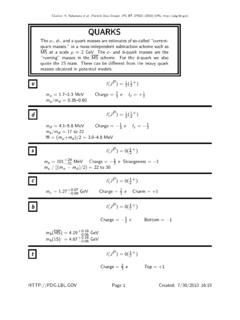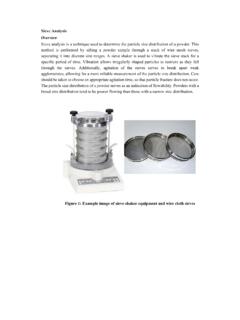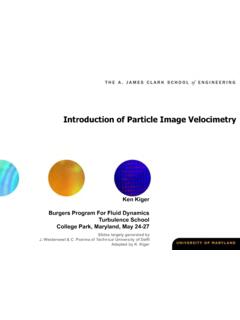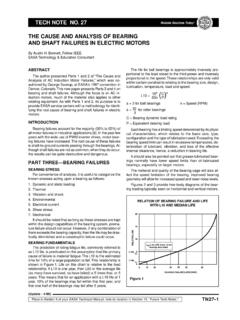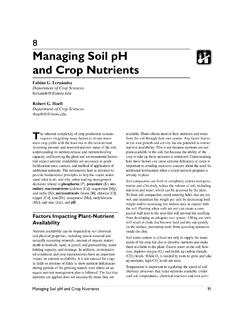Transcription of 34. Monte Carlo particle numbering scheme 1
1 34. Monte Carlo particle numbering scheme134. Monte Carlo particle numbering SCHEMER evised June 2006 by L. Garren (Fermilab), Knowles (Edin-burgh U.), S. Navas (U. Granada), P. Richardson (Durham U.),T. Sj ostrand (Lund U.), and T. Trippe (LBNL).The Monte Carlo particle numbering scheme presented here isintended to facilitate interfacing between event generators, detectorsimulators, and analysis packages used in particle physics. Thenumbering scheme was introduced in 1988 [1] and a revisedversion [2,3] was adopted in 1998 in order to allow systematic inclusionof quark model states which are as yet undiscovered and hypotheticalparticles such as SUSY particles . The numbering scheme is used inseveral event generators, and PYTHIA/JETSET, andin the/HEPEVT/[4] standard general form is a 7 digit number: encodes information about the particle s spin, flavor content, andinternal quantum numbers.
2 The details are as follows:1. particles are given positive numbers, antiparticles negativenumbers. The PDG convention for mesons is used, so thatK+andB+are Quarks and leptons are numbered consecutively starting from 1and 11 respectively; to do this they are first ordered by familyand within families by weak In composite quark systems (diquarks, mesons, and baryons)nq1 3are quark numbers used to specify the quark content, whilethe rightmost digitnJ=2J+ 1 gives the system s spin (exceptfor theK0 SandK0L). The scheme does not cover particles of spinJ> Diquarks have 4-digit numbers withnq1 nq2andnq3= The numbering of mesons is guided by the nonrelativistic (L Sdecoupled) quark model, as listed in Tables and The numbers specifying the meson s quark content conformto the conventionnq1=0andnq2 nq3. The special caseK0 Lis the sole exception to this The quark numbers of flavorless, light (u, d, s)mesonsare:11 for the member of the isotriplet ( 0, 0.)
3 , 22 for thelighter isosinglet ( , ,..), and 33 for the heavier isosinglet( , ,..). Since isosinglet mesons are often large mixturesofuu+ddandssstates, 22 and 33 are assigned by mass anddo not necessarily specify the dominant quark The special numbers 310 and 130 are given to The fifth digitnLis reserved to distinguish mesons of thesame total (J) but different spin (S) and orbital (L) angularmomentum quantum numbers. ForJ>0thenumbersare:(L, S)=(J 1,1)nL=0,(J,0)nL=1,(J,1)nL=2and (J+1,1)nL= 3. For the exceptional caseJ=0thenumbers are (0,0)nL=0and(1,1)nL=1( ).See Table :Meson numbering logic. Hereqqstands 1,S=1L=J,S=0L=J,S=1L=J+1,S=1 JcodeJPCL codeJPCL codeJPCL codeJPCL0 00qq10 +0 10qq10++1100qq31 010qq31+ 120qq31++130qq31 2200qq52++110qq52 +220qq52 230qq52++3300qq73 210qq73+ 320qq73++330qq73 4400qq94++310qq94 +420qq94 430qq94++5e. If a set of physical mesons correspond to a (non-negligible)mixture of basis states, differing in their internal quantumnumbers, then the lightest physical state gets the smallestbasis state number.
4 For example theK1(1270) is numbered10313 (11P1K1B)andtheK1(1400) is numbered 20313(13P1K1A).f. The sixth digitnris used to label mesons radially excitedabove the ground Numbers have been assigned for completenr=0S-andP-wave multiplets, even where states remain to be In some instances assignments within theq qmeson modelare only tentative; here best guess assignments are Many states appearing in the Meson Listings are not yetassigned within theq qmodel. Herenq2 3andnJareassigned according to the state s likely flavors and spin; allsuch unassigned light isoscalar states are given the flavorcode 22. Within these groupsnL=0,1,2,..is used todistinguish states of increasing mass. These states are flaggedusingn= 9. It is to be expected that these numbers willevolve as the nature of the states are elucidated. Codes areassigned to all mesons which are listed in the one-page tableat the end of the Meson Summary Table as long as they havea prefered or established spin.
5 Additional heavy meson statesexpected from heavy quark spectroscopy are also The numbering of baryons is again guided by the nonrelativisticquark model, see Table The numbers specifying a baryon s quark content are suchthat in generalnq1 nq2 Two states exist forJ=1/2 baryons containing 3 differenttypes of quarks. In the lighter baryon ( , , ,..)thelightquarks are in an antisymmetric (J= 0) state while forthe heavier baryon ( 0, , ,..)theyareinasymmetric(J= 1) state. In this situationnq2andnq3are reversed forthe lighter state, so that the smaller number corresponds tothe lighter At present most Monte Carlos do not include excited baryonsand no systematic scheme has been developed to denotethem, though one is foreseen. In the meantime, use of thePDG 96 [5] numbers for excited baryons is For pentaquark statesn=9,nrnLnq1nq2gives the fourquark numbers in ordernr nL nq1 nq2,nq3gives theantiquark number, andnJ=2J+ 1, with the assumptionthatJ=1/2 for the states currently The gluon, when considered as a gauge boson, has official number21.
6 In codes for glueballs, however, 9 is used to allow a notationin close analogy with that of The pomeron and odderon trajectories and a generic reggeontrajectory of states in QCD are assigned codes 990, 9990, and 110respectively, where the final 0 indicates the indeterminate natureof the spin, and the other digits reflect the expected valence flavor content. We do not attempt a complete classification of allreggeon trajectories, since there is currently no need to distinguisha specific such trajectory Two-digit numbers in the range 21 30 are provided for theStandard Model gauge bosons and Codes 81 100 are reserved for generator-specific pseudoparticlesand The search for physics beyond the Standard Model is an activearea, so these codes are also standardized as far as A standard fourth generation of fermions is included byanalogy with the first The graviton and the boson content of a two-Higgs-doubletscenario and of additional SU(2) U(1) groups are found inthe range 31 One-of-a-kind exotic particles are assigned numbers in therange 41 Fundamental supersymmetric particles are identified byadding a nonzeronto the particle number.
7 The superpartnerof a boson or a left-handed fermion hasn= 1 while thesuperpartner of a right-handed fermion hasn=2. Whenmixing occurs, such as between the winos and chargedHiggsinos to give charginos, or between left and rightsfermions, the lighter physical state is given the smaller basisstate Technicolor states haven= 3, with technifermions treatedlike ordinary fermions. States which are ordinary colorsinglets havenr= 0. Color octets havenr=1. Ifastatehas non-trivial quantum numbers under the topcolor groups234. Monte Carlo particle numbering schemeSU(3)1 SU(3)2, the quantum numbers are specified bytech,ij,whereiandjare 1 or then 2i+ ,V8, is a heavy gluon color octet and thus is Excited (composite) quarksand leptons are identified bysettingn= Within several scenarios of new physics, it is possible tohave colored particles sufficiently long-lived for color-singlethadronic states to form around them.
8 In the context ofsupersymmetric scenarios, these states are calledR-hadrons,since they carry codes, defined here,should be viewed as templates for corresponding codes alsoin other scenarios, for any long-lived particle that is eitheran unflavored color octet or a flavored color triplet. TheR-hadron code is obtained by combining the SUSY particlecode with a code for the light degrees of freedom, with asmany intermediate zeros removed from the former as requiredto make place for the latter at the end. (To exemplify, asparticlen00000n qcombined with quarksq1andq2obtainscoden00n qnq1nq2nJ.) Specifically, the new- particle spindecouples in the limit of large masses, so that the finalnJdigit is defined by the spin state of the light-quark systemalone. An appropriate number ofnqdigits is used to definethe ordinary-quark content. As usual, 9 rather than 21 isused to denote a gluon/gluino in composite states.
9 The signof the hadron agrees with that of the constituent new particle (a color triplet) where there is a distinct new antiparticle,and else is defined as for normal hadrons. particle names areRwith the flavor content as lower index. A non-exhaustivelist ofR-hadron codes is given Occasionally program authors add their own states. To avoidconfusion, these should be flagged by settingnnr= Concerning the non-99 numbers, it may be noted that onlyquarks, excited quarks, squarks, and diquarks havenq3=0;onlydiquarks, baryons (including pentaquarks), and the odderon havenq1 = 0; and only mesons, the reggeon, and the pomeron havenq1=0andnq2 = 0. Concerning mesons (not antimesons), ifnq1is odd then it labels a quark and an antiquark if Nuclear codes are given as 10-digit numbers a (hyper)nucleus consisting ofnpprotons,nnneutrons andn s,A=np+nn+n gives the total baryon number,Z=npthe total charge andL=n the total number of strange the isomer level, withI= 0 corresponding to the groundstate andI>0toexcitations,see [9], where states denotedm, n, p, qtranslate toI=1 4.
10 As examples, the deuteronis 1000010020 and235U is 1000922350. To avoid ambiguities,nuclear codes should not be applied to a single hadron, likep,nor 0, where quark-contents-based codes already text and lists of particle numbers can be found on theWWW [6]. The StdHep Monte Carlo standardization project [7]maintains the list of PDG particle numbers, as well as numberingschemes from most event generators and software to convert betweenthe different :1. Yostet al., particle Data Group, Phys. , 1 (1988).2. I. G. Knowleset al.,in Physics at LEP2 , CERN 96-01, vol. 2,p. C. Casoet al., particle Data Group, Eur. Phys. , 1 (1998).4. T. Sj ostrandet al.,in Zphysics at LEP1 , CERN 89-08, vol. 3,p. Barnettet al.,PDG, , 1 (1996). L. Garren, StdHep, Monte Carlo Standardization at FNAL,Fermilab PM0091 and StdHep WWW site: S. Eidelmanet al.
